-
 Bitcoin
Bitcoin $107,352.1067
0.28% -
 Ethereum
Ethereum $2,429.3531
-0.90% -
 Tether USDt
Tether USDt $1.0001
-0.02% -
 XRP
XRP $2.1894
4.62% -
 BNB
BNB $646.7968
0.36% -
 Solana
Solana $147.4290
4.03% -
 USDC
USDC $0.9998
-0.02% -
 TRON
TRON $0.2756
1.52% -
 Dogecoin
Dogecoin $0.1630
1.14% -
 Cardano
Cardano $0.5612
1.18% -
 Hyperliquid
Hyperliquid $37.0580
-0.05% -
 Bitcoin Cash
Bitcoin Cash $496.9410
-0.09% -
 Sui
Sui $2.7318
3.19% -
 Chainlink
Chainlink $13.1503
0.58% -
 UNUS SED LEO
UNUS SED LEO $9.0766
0.55% -
 Avalanche
Avalanche $17.7220
1.46% -
 Stellar
Stellar $0.2380
1.52% -
 Toncoin
Toncoin $2.8439
0.38% -
 Shiba Inu
Shiba Inu $0.0...01143
1.84% -
 Litecoin
Litecoin $85.8053
1.47% -
 Hedera
Hedera $0.1483
2.70% -
 Monero
Monero $314.3240
2.12% -
 Bitget Token
Bitget Token $4.6725
0.77% -
 Dai
Dai $1.0000
0.00% -
 Polkadot
Polkadot $3.3555
1.28% -
 Ethena USDe
Ethena USDe $1.0001
0.02% -
 Uniswap
Uniswap $7.0890
2.64% -
 Pi
Pi $0.5355
-3.40% -
 Pepe
Pepe $0.0...09393
1.06% -
 Aave
Aave $256.8136
-1.90%
Is USDT withdrawal anonymous? Will there be a record?
USDT withdrawals are not anonymous; transactions are recorded on the blockchain and linked to identities via KYC on exchanges, ensuring regulatory compliance.
May 12, 2025 at 05:36 pm
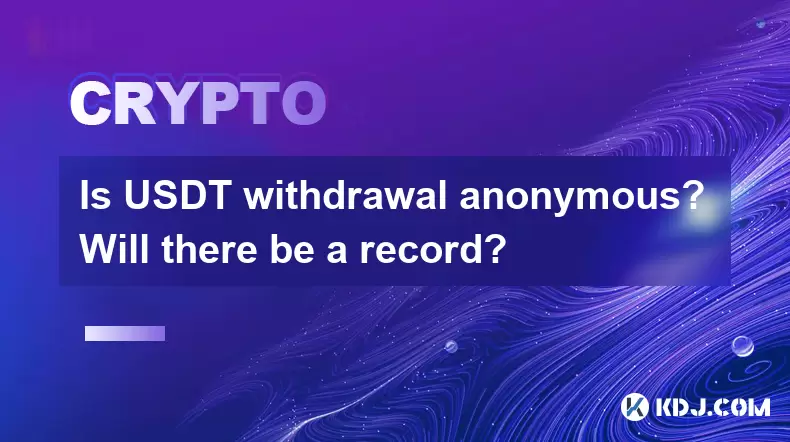
Is USDT withdrawal anonymous? Will there be a record?
When it comes to the world of cryptocurrencies, privacy and anonymity are often at the forefront of users' minds. One common question that arises is whether withdrawing USDT, a popular stablecoin, is an anonymous process, and if there will be any records of the transaction. In this article, we will delve into the intricacies of USDT withdrawals, exploring the level of anonymity and the potential records that may be kept.
Understanding USDT and Its Blockchain
USDT, or Tether, is a stablecoin that is pegged to the value of the US dollar. It is built on various blockchains, including Bitcoin's Omni Layer, Ethereum's ERC-20, and Tron's TRC-20. Each of these blockchains has its own characteristics when it comes to privacy and transparency.
- Omni Layer: Built on the Bitcoin blockchain, transactions on the Omni Layer are recorded on the Bitcoin blockchain. While Bitcoin transactions are pseudonymous, meaning they are linked to addresses rather than real-world identities, they are still publicly visible.
- ERC-20: On the Ethereum blockchain, USDT transactions are also pseudonymous but visible on the public ledger. Ethereum's smart contract nature allows for more complex transactions but does not inherently provide additional privacy.
- TRC-20: The Tron blockchain offers similar characteristics to Ethereum, with transactions being pseudonymous and publicly visible.
The Anonymity of USDT Withdrawals
When you withdraw USDT, the level of anonymity largely depends on the platform you are using and the blockchain on which the USDT is issued. Here are some key points to consider:
- Exchange Platforms: Most cryptocurrency exchanges require users to complete Know Your Customer (KYC) procedures. This means that when you withdraw USDT from an exchange, the exchange has a record of your identity and the transaction. Even though the transaction itself on the blockchain is pseudonymous, the exchange can link it back to your real-world identity.
- Wallets and Private Transactions: If you use a non-custodial wallet, where you control your private keys, the level of anonymity can be higher. However, the transaction will still be visible on the blockchain. To enhance privacy, you might use mixing services or privacy-focused cryptocurrencies, but these come with their own risks and complexities.
Records of USDT Withdrawals
Every USDT transaction, regardless of the blockchain it is on, leaves a record on the public ledger. Here's how these records are maintained:
- Blockchain Transparency: All transactions on the blockchain are immutable and publicly accessible. Anyone can view the transaction details, including the sender's and recipient's addresses and the amount transferred.
- Exchange Records: As mentioned earlier, exchanges keep detailed records of all transactions, including withdrawals. These records are linked to the user's identity through KYC processes.
- Regulatory Compliance: Exchanges and other financial institutions are often required by law to maintain transaction records for a certain period. This is to comply with anti-money laundering (AML) and counter-terrorism financing (CTF) regulations.
Steps to Withdraw USDT
If you are interested in withdrawing USDT, here are the steps you might follow, depending on whether you are using an exchange or a non-custodial wallet:
Using an Exchange:
- Log into your exchange account.
- Navigate to the withdrawal section.
- Select USDT as the cryptocurrency you want to withdraw.
- Enter the destination address (your wallet address).
- Specify the amount of USDT you wish to withdraw.
- Confirm the transaction details and any associated fees.
- Complete any required two-factor authentication (2FA).
- Submit the withdrawal request.
Using a Non-Custodial Wallet:
- Open your wallet application.
- Select the option to send or transfer USDT.
- Enter the recipient's address.
- Specify the amount of USDT you want to send.
- Review the transaction details and any network fees.
- Confirm the transaction using your private key or seed phrase.
- The transaction will be broadcast to the blockchain.
Enhancing Privacy During USDT Withdrawals
While USDT withdrawals are not inherently anonymous, there are steps you can take to enhance your privacy:
- Use Privacy-Focused Wallets: Some wallets offer additional privacy features, such as coin mixing or integration with privacy-focused cryptocurrencies.
- Avoid Reusing Addresses: Using a new address for each transaction can make it harder to link transactions to a single user.
- Utilize VPNs and Tor: Using a Virtual Private Network (VPN) or the Tor network can help mask your IP address when conducting transactions.
- Consider Decentralized Exchanges (DEXs): DEXs often do not require KYC, which can provide a higher level of anonymity compared to centralized exchanges.
The Role of KYC and AML Regulations
KYC and AML regulations play a significant role in the anonymity of USDT withdrawals. These regulations are designed to prevent illegal activities such as money laundering and terrorist financing. Here's how they impact USDT withdrawals:
- KYC Requirements: Exchanges and other financial institutions must verify the identity of their users. This means that when you withdraw USDT from an exchange, your identity is linked to the transaction.
- AML Monitoring: Transactions are monitored for suspicious activity. Large or frequent withdrawals may trigger additional scrutiny, and records of these transactions are kept for regulatory compliance.
- Impact on Anonymity: While the blockchain itself is pseudonymous, the combination of KYC and AML regulations means that your identity can be traced back to your USDT withdrawals through the exchange or financial institution.
Conclusion
In conclusion, withdrawing USDT is not an anonymous process due to the public nature of blockchain transactions and the KYC and AML regulations enforced by exchanges and financial institutions. Every USDT withdrawal leaves a record on the blockchain and, in many cases, with the platform from which the withdrawal is made. While there are steps you can take to enhance your privacy, complete anonymity is challenging to achieve within the current framework of the cryptocurrency ecosystem.
Frequently Asked Questions
Q1: Can I use a VPN to make my USDT withdrawals completely anonymous?
A: While using a VPN can help mask your IP address and enhance your privacy, it does not make your USDT withdrawals completely anonymous. The transaction itself is still recorded on the blockchain, and if you are using an exchange, your identity is linked to the transaction through KYC processes.
Q2: Are there any cryptocurrencies that offer more anonymity than USDT for withdrawals?
A: Yes, there are cryptocurrencies designed with privacy in mind, such as Monero (XMR) and Zcash (ZEC). These cryptocurrencies use advanced cryptographic techniques to obscure transaction details, offering a higher level of anonymity compared to USDT.
Q3: How long are records of USDT withdrawals kept by exchanges?
A: The duration for which exchanges keep records of USDT withdrawals can vary based on the jurisdiction and specific regulations they must comply with. Generally, records are kept for a minimum of five years to comply with AML and CTF regulations, but some jurisdictions may require longer retention periods.
Q4: Can I withdraw USDT to a hardware wallet to increase my privacy?
A: Withdrawing USDT to a hardware wallet can enhance your control over your private keys and potentially increase your privacy. However, the transaction itself is still recorded on the blockchain, and if you are withdrawing from an exchange, your identity is linked to the transaction through KYC processes.
Disclaimer:info@kdj.com
The information provided is not trading advice. kdj.com does not assume any responsibility for any investments made based on the information provided in this article. Cryptocurrencies are highly volatile and it is highly recommended that you invest with caution after thorough research!
If you believe that the content used on this website infringes your copyright, please contact us immediately (info@kdj.com) and we will delete it promptly.
- Across Crypto Project Faces Heat: Secret $23M Transfer Sparks Governance Debate
- 2025-06-28 16:30:13
- Trump Coin's Wild Ride: Liquidity Drain, Exchange Deposits, and What It Means for Binance & OKX
- 2025-06-28 16:50:13
- Solana, XRP, and Spot ETFs: A New York Minute on Crypto's Shifting Sands
- 2025-06-28 17:10:13
- Trump, Memecoin Mania, and Whale Watching: A New York Minute in Crypto
- 2025-06-28 16:30:13
- Gemini, Tokenized Stocks, and Europe: A New Era for Investment?
- 2025-06-28 17:10:13
- Shiba Inu, Lending Coins, and Early Holders: A New Frontier
- 2025-06-28 16:51:59
Related knowledge

How to choose a reliable USDT exchange service provider? How to identify?
Jun 12,2025 at 03:15pm
Understanding the Role of USDT in Cryptocurrency TradingUSDT (Tether) is one of the most widely used stablecoins in the cryptocurrency market. It is designed to maintain a 1:1 peg with the U.S. dollar, offering traders and investors a way to hedge against volatility while remaining within the crypto ecosystem. Choosing a reliable USDT exchange service p...
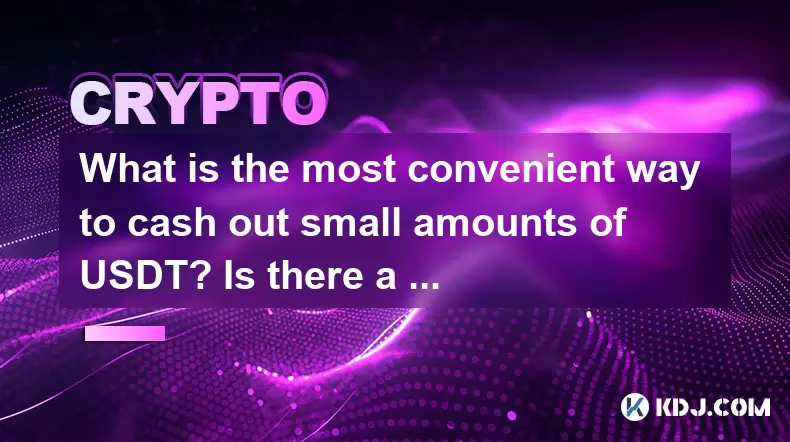
What is the most convenient way to cash out small amounts of USDT? Is there a shortcut?
Jun 11,2025 at 11:00pm
Understanding the Need to Cash Out Small USDT AmountsCashing out small amounts of USDT can be a challenge for many crypto users. Traditional methods often involve high fees, minimum withdrawal limits, or cumbersome verification processes that make it inefficient for small transactions. The key is to find a method that balances speed, cost, and convenien...
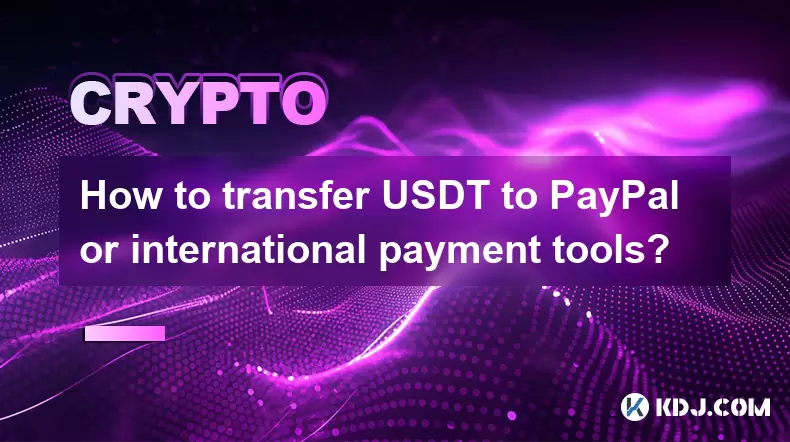
How to transfer USDT to PayPal or international payment tools?
Jun 15,2025 at 05:28am
Understanding the Basics of USDT and PayPal IntegrationUSDT (Tether) is a stablecoin pegged to the US dollar, offering blockchain-based value transfer with minimal volatility. PayPal, on the other hand, is a centralized digital wallet that facilitates fiat currency transactions globally. Direct integration between USDT and PayPal does not exist due to t...
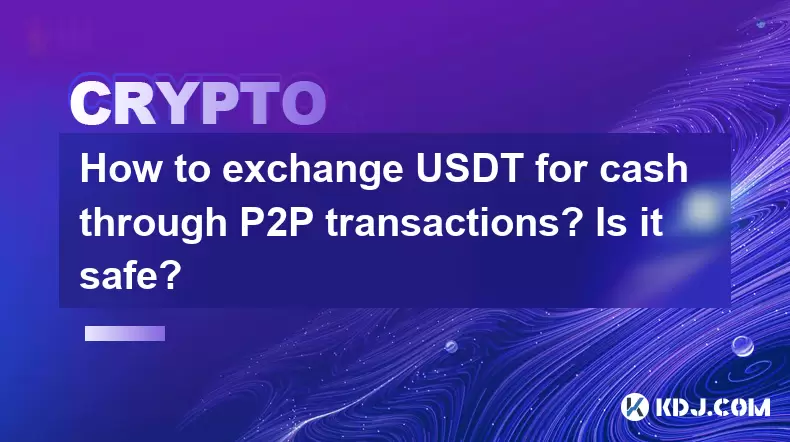
How to exchange USDT for cash through P2P transactions? Is it safe?
Jun 18,2025 at 07:56am
Understanding USDT and P2P TransactionsTether (USDT) is a stablecoin pegged to the value of the US dollar, making it a popular choice for users who want to avoid the volatility of other cryptocurrencies while still participating in the crypto ecosystem. Peer-to-peer (P2P) transactions allow individuals to trade directly with each other without going thr...
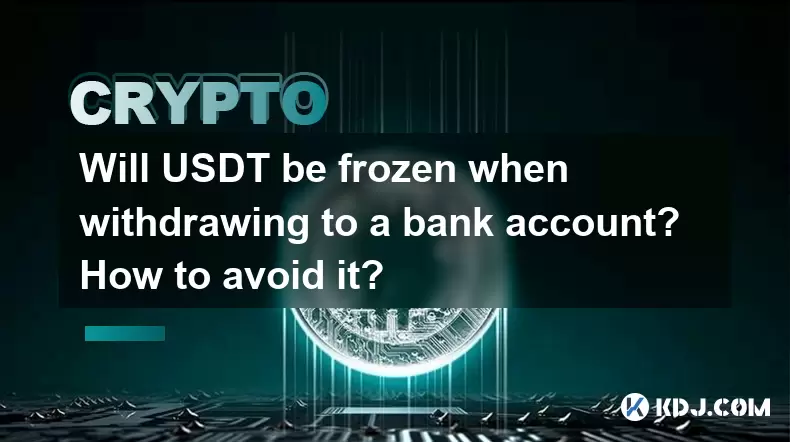
Will USDT be frozen when withdrawing to a bank account? How to avoid it?
Jun 15,2025 at 10:03am
Understanding USDT Withdrawals and Bank Account Freezing RisksWhen users decide to withdraw USDT (Tether) to a bank account, one of the most common concerns is whether their funds will be frozen during the process. This concern stems from real-life cases where individuals have encountered delays or restrictions when converting digital assets into fiat c...

How to avoid risks when exchanging USDT for cash? What are the pitfalls?
Jun 11,2025 at 08:14pm
Understanding the Risks of Exchanging USDT for CashWhen exchanging USDT (Tether) for cash, users must be aware of the potential risks involved. As a stablecoin pegged to the US dollar, USDT is widely used in crypto transactions due to its price stability. However, converting it into fiat currency like USD or CNY can expose users to several pitfalls, inc...

How to choose a reliable USDT exchange service provider? How to identify?
Jun 12,2025 at 03:15pm
Understanding the Role of USDT in Cryptocurrency TradingUSDT (Tether) is one of the most widely used stablecoins in the cryptocurrency market. It is designed to maintain a 1:1 peg with the U.S. dollar, offering traders and investors a way to hedge against volatility while remaining within the crypto ecosystem. Choosing a reliable USDT exchange service p...

What is the most convenient way to cash out small amounts of USDT? Is there a shortcut?
Jun 11,2025 at 11:00pm
Understanding the Need to Cash Out Small USDT AmountsCashing out small amounts of USDT can be a challenge for many crypto users. Traditional methods often involve high fees, minimum withdrawal limits, or cumbersome verification processes that make it inefficient for small transactions. The key is to find a method that balances speed, cost, and convenien...

How to transfer USDT to PayPal or international payment tools?
Jun 15,2025 at 05:28am
Understanding the Basics of USDT and PayPal IntegrationUSDT (Tether) is a stablecoin pegged to the US dollar, offering blockchain-based value transfer with minimal volatility. PayPal, on the other hand, is a centralized digital wallet that facilitates fiat currency transactions globally. Direct integration between USDT and PayPal does not exist due to t...

How to exchange USDT for cash through P2P transactions? Is it safe?
Jun 18,2025 at 07:56am
Understanding USDT and P2P TransactionsTether (USDT) is a stablecoin pegged to the value of the US dollar, making it a popular choice for users who want to avoid the volatility of other cryptocurrencies while still participating in the crypto ecosystem. Peer-to-peer (P2P) transactions allow individuals to trade directly with each other without going thr...

Will USDT be frozen when withdrawing to a bank account? How to avoid it?
Jun 15,2025 at 10:03am
Understanding USDT Withdrawals and Bank Account Freezing RisksWhen users decide to withdraw USDT (Tether) to a bank account, one of the most common concerns is whether their funds will be frozen during the process. This concern stems from real-life cases where individuals have encountered delays or restrictions when converting digital assets into fiat c...

How to avoid risks when exchanging USDT for cash? What are the pitfalls?
Jun 11,2025 at 08:14pm
Understanding the Risks of Exchanging USDT for CashWhen exchanging USDT (Tether) for cash, users must be aware of the potential risks involved. As a stablecoin pegged to the US dollar, USDT is widely used in crypto transactions due to its price stability. However, converting it into fiat currency like USD or CNY can expose users to several pitfalls, inc...
See all articles
























































































